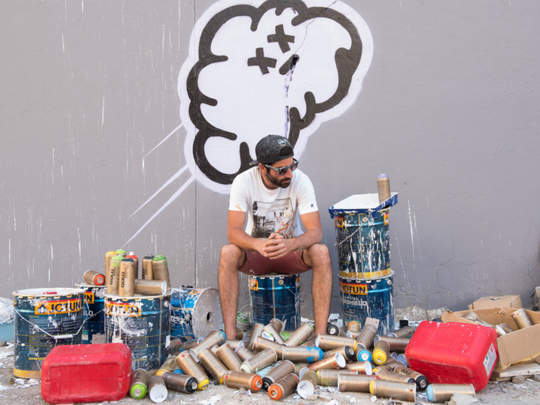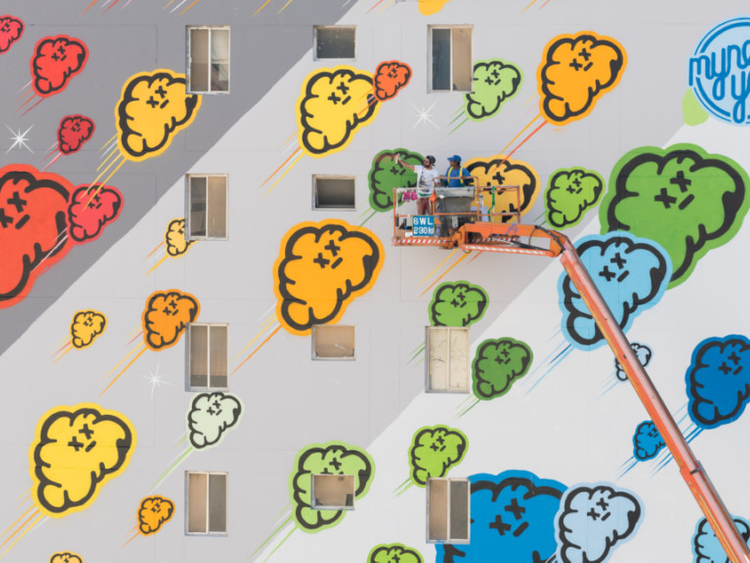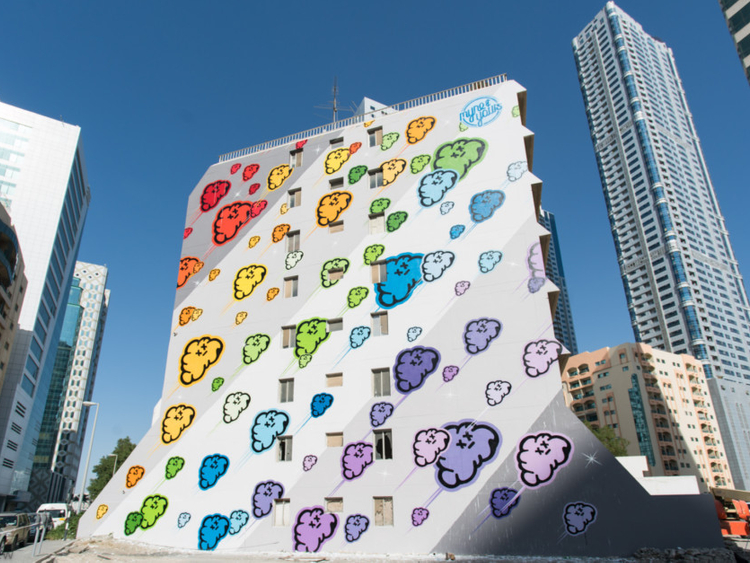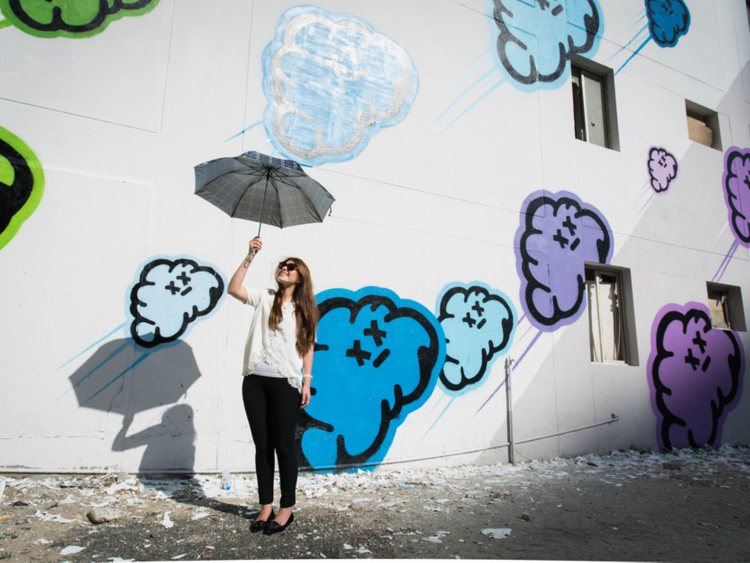
Colourful clouds rise from the ground to the sky against a grey backdrop, with lines which follow them representing motion.
It is a mural that takes up the entire side of a building in Al Khan in Sharjah. Anyone who stumbles upon it in that neighbourhood will be pleasantly surprised.
Tantalisingly titled “There’s an Angle to Everything” by Marwan Shakarchi from MyneandYours, it signifies the common impulse in people to develop and move forward. This, the artist says, also “reflects in all great initiatives, industries and cities, in particular art in Sharjah and the UAE.”
Jedariya, the live street art initiative by Maraya Art Centre, in its second edition brings Shakarchi’s work to life in the outdoors and thus attempts to beautify city areas.
The first edition of Jedariya saw the striking “calligraffiti” of acclaimed French-Tunisian street artist eL Seed — fusing elements of both the graffiti and Arabic calligraphic traditions — for the first time in Sharjah, with an elaborate painted calligraphy-styled mural on the walls of the Sharjah Bank Street building.
Cloud symbol
Shakarchi, who is of Iraqi origin, was born and raised in London. He moved to Dubai two years ago to pursue a full-time career in the arts, leaving the world of marketing as he felt the need to express himself.
While in London, experimenting in his spare time, he came up with the image of a cloud caricature with ‘x’s for eyes.
The cloud symbol became his signature that represents his practice and even became synonymous with the artist. Interested in symbol repetition, Shakarchi used to leave his mark on new surfaces, giving people who come across it something to think about.
Now with a much larger canvas, he hopes that his symbol will “open up a dialogue with the public, to inspire them to dream big, and to brighten up their day with strong colours and a positive message.”
Giuseppe Moscatello, director of Maraya Art Centre, says that Shakarchi has been on their list for some time now, and is also thrilled by the fact that this artist has never been given a big wall, always working on smaller dimensions and stickers. “The challenge and the ambition was basically to see the reaction and outcomes of this young artist on a big wall.”
Graffiti art is considered vandalism everywhere in the world. Seen in that light, for Maraya Art Centre, Jedariya is a challenging project. “Despite this, the visual representations of many of these artworks are stunning and very appealing, and therefore they embellish the urban environment if curated and controlled the same way Jedariya is aiming to do,” he says. “The aim is to bring art and creative representation to the whole community of Sharjah, and not strictly to the art enthusiasts.”
Shakarchi spoke to Weekend Review about his work and inspiration. Excerpts:
What is your academic background and how did you get involved in arts in the UK?
I have an Economics degree, albeit gathering dust somewhere. It was the catalyst that persuaded me to look at our environment in a different light, and set me on a somewhat artistic path. It gave me a reason to begin visually communicating first with myself, and later with an audience.
How has your art practice developed since shifting base to Dubai?
I’ve been in Dubai for two years, and working on Myneandyours full-time since I arrived. Working solely on this has given me the opportunity to live and breathe the project, and fully immerse myself in it. I think it’s difficult to do anything significant unless you become part of it, and allow it to become every part of you.
How effective is the cloud symbol in representing your artistic practice, and what awareness has it created?
I began sticking the cloud on my way to work in London around five years ago. I did it to cheer me up before I sat at my desk juggling Excel sheets for eight hours. Once an audience began reacting to it, I became aware of the power a symbol can hold. Once people started to question it, I began to question it. I slowly began to develop a story, and a project that represented my situation, which would hopefully begin to persuade people to question their own situations.
Tell us about the internship with Shepard Fairey and his influence on your work.
I was fascinated by the Obey Giant campaign even before I really knew what it was. Once I began to develop a relationship with it, I began to understand the potency behind believing in something. Interning for Fairey was a fundamental moment for me in witnessing what it takes to make something out of nothing. Aside from working alongside a mentor, it showed me a world I had only previously imagined.
How did the Jedariya mural at Al Khan in Sharjah come about? How was the experience of working with Maraya Art Centre?
Maraya approached me a while ago with the intention of working towards a public mural. There were no commercial motives, and no financial gain — a concept sometimes misunderstood and a concept I believe in. Across this region, public murals are rare. The streets are crowded with advertising in a landscape where you are always being sold something, and this is true of any developed economy. When you create imagery that is not trying to push you in any direction, it spurs curiosity and begins to persuade you to see things somewhat differently than what you are used to. Maraya understand this, and are willing to pioneer initiatives that make sense to me.
Tell us how the project was implemented on site — the logistics involved and the planning that went into it?
My work is meticulously planned. My sketchbook is, funnily enough, lined with more equations than sketches. The work in Sharjah was created at a 45° angle to the building. Its title “There’s an Angle to Everything” implies that if you look at something in a different way you may see something you were previously unaware of.
To achieve this we had to work with the building, in constructing the angles and making sure everything was perfectly in line with each other. I never thought I would use rope, and a drill in a mural, but they turned out to be our best friends. My team of trusted rebels and I completed the mural in 10 days. Without them I would have been there for a lot longer.
What’s been the initial reactions to the mural? Is this what you set out to achieve?
It was interesting to watch a confused audience gather as the mural went up. Public work is alien to most in Sharjah, and many questioned why we were doing it. Any reaction has value, and if you can show someone something new, then I have kind of achieved what I was after. Many of them waited for the punch line, the final bit of text that reveals the idea, the tool of persuasion, but were surprised to see us come down, and wipe our hands clean, leaving only a bunch of clouds. I think that’s when many warmed up to the idea and began thanking us for brightening up their neighbourhood.
What’s even more satisfying is making a community feel important. When you come into someone’s hometown from the outside and develop something so pure, it becomes a sort of a gift to the area, and makes the people feel important.
N.P. Krishna Kumar is a freelance writer based in Dubai.















